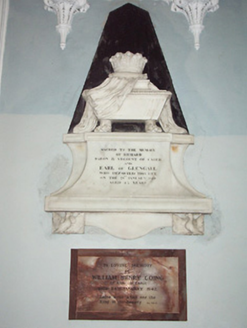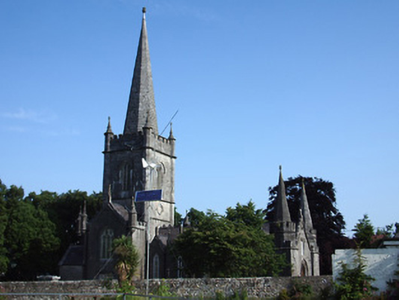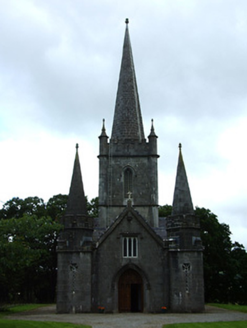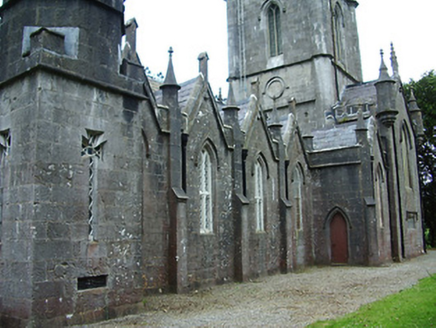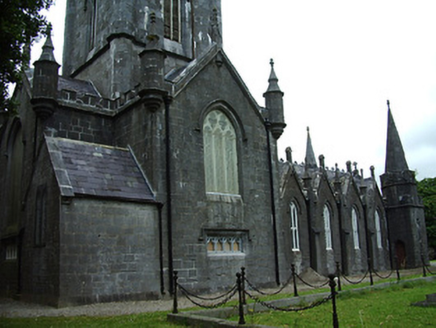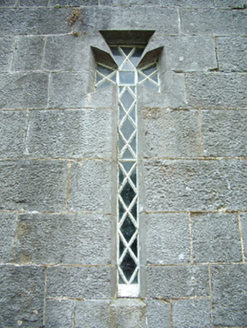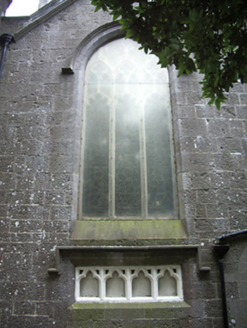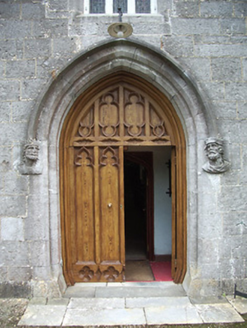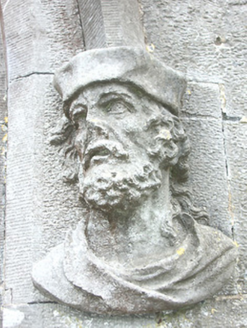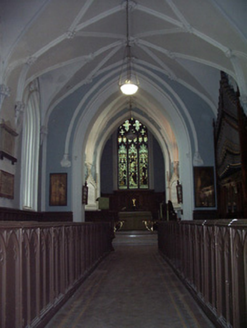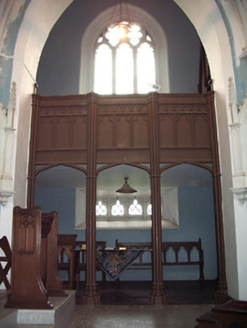Survey Data
Reg No
22111019
Rating
International
Categories of Special Interest
Architectural, Artistic, Historical, Social
Original Use
Church/chapel
In Use As
Church/chapel
Date
1815 - 1820
Coordinates
205190, 125033
Date Recorded
07/06/2005
Date Updated
--/--/--
Description
Freestanding cruciform-plan church, built 1816-18, with five-bay nave having gable-fronts to all windows, vestry to north elevation, crossing tower with spire, and entrance gable-front flanked by towers with spires. Pitched slate roof, with decorative ridge cresting, octagonal-plan ashlar limestone spires, cut limestone copings to all gables, crenellations to parapets at east end, gabled pinnacles to nave window gables having flared octagonal conical cut limestone pinnacles over buttresses between bays, octagonal miniature tourelles to corners of chancel and transepts supported on moulded corbels and topped with stepped conical pinnacles. Crossing tower has snecked cut limestone walls, moulded string courses, engaged octagonal buttresses to corners topped by pinnacles similar to those of chancel and transepts, crenellated parapets and octagonal spire with finial. Coursed cut limestone walls with battered plinth course and stepped buttresses between nave bays and to vestry. Pointed arch mullioned and transomed window openings to nave, triple-light windows to transepts and east elevation, all with chamfered surrounds, hood-mouldings and timber frame windows with stained glass. Reticulated tracery to upper transepts and east end of chancel, mullioned and transomed to nave with lattice glazing and three-light. Square-headed window openings with chamfered surrounds, label-mouldings and group of four trefoil-headed timber windows to lower walls of transepts and east elevation. Cross loops with lattice glazing to front and side elevations of towers flanking entrance. Pointed arch louvred windows to tower with chamfered surrounds, Y-tracery and hood mouldings. Pointed arch two-order entrance opening to west elevation, with battered plinth, hood-moulding having carved head stops, ornate panelling to timber double-leaf door, stone step, and stone flagged threshold. Pointed arch entrance opening to vestry with chamfered surround, battered plinth, and decorative arcade detail to timber battened door. Timber panelled box pews to interior with trefoil-headed side panels and individual doors. Carved timber galleries to west and transepts with trefoil and quatrefoil details and Tudor arches below between clustered columns. Carved timber lecterns, eagle lectern, benches, and pulpit, organ installed in 1896 to north side, variety of marble and brass memorial plaques to north and south walls of nave and tiled pavement to floor. Moulded ribs with ornate stops and stuuco bosses to ceiling. Heads to stops of hood moulding to chancel arch. Stained glass window 1930 by Sir Ninian Comper depicting knight in full armour. Random rubble stone plinth walls to boundary, having cut limestone copings and octagonal coursed limestone piers with moulded caps and bases, wrought-iron railings and double-leaf vehicular and single-leaf pedestrian gates, and cast-iron bollards.
Appraisal
This church is one of only two churches designed by the celebrated English architect John Nash. It is a very accomplished Gothic Revival work and its dramatic spire is a major landmark in the town of Cahir. The decorative smaller spires and pinnacles to the exterior emphasise the fine tower and spire by drawing the eye up at all points. The high-quality ashlar limestone walls, parapets and crenellations, as well as the hood mouldings and the variety of windows, all add to the visual appeal of the building. The interior is also very fine and intact, having decoratively-carved box pews, timber galleries, lecterns and pulpits. The carved heads to the stops of some hood mouldings are an unusual feature, contributing to the distinctive character of this well-maintained and richly-decorated church.
